Letters: Lipitor versus generics
- Share via
Thanks for assisting your readers now negotiating the array of issues surrounding Lipitor (atorvastatin) and the expiration of its patent [“The New Deal With Lipitor,” Jan. 16].
When a drug has generated $81 billion, the manufacturer will do all it can to preserve a portion of that income stream. They cite the drug’s fine track record and play on the status of the brand. Patients should consider that neither track records nor status can lower cholesterol.
It will take at least six months for this drug to be fully available with generic pricing. At that point, the take-home message should be that Lipitor is just a brand of atorvastatin. Although generic atorvastatin will differ from the branded product in the inactive ingredients, such as coloring, these differences will be inconsequential for the vast majority of patients. Additionally, any patient who suspects that the generic version may not be equivalent can simply ask the prescriber to run a blood panel.
The issues outlined in your article go well beyond Lipitor. Millions of Americans take expensive branded drugs when an equivalent generic could easily be substituted. When prescribed drugs work well, doctors may avoid spending the time to discuss financial issues and patients may not want to “rock the boat.” More attention to generic prescribing could save consumers and the healthcare system billions of dollars.
Dr. Daniel J. Stone
Medical director, Cedars-Sinai Health Associates
Beverly Hills
::
I’m taking issue with Joe Graedon on generic versus brand drugs. He cites three reasons for problems with generics. One is that generics have different inactive ingredients. Brand-name companies change their inactive ingredients all the time. If the changes are significant, they have to do a side-by-side comparison with their previous formula.
Graedon also says generics can have contaminants from uninspected foreign manufacturing plants. This happens with brand-name drugs as well. Not all are made in the U.S.
Finally, he says generics are released in the blood differently from branded drugs. Generics are tested side-by-side with the brands for release in the blood. When the formula for a brand is changed, it goes through the same testing as a generic.
I was in the pharmaceutical industry for 20 years, working on brand-name and generic drugs. Generics are as safe and effective as their brands.
Mary E. Petit
Upland
Yes, they hear her
Thank you, Terri Goldstein, for a validating article about the complexity of hearing loss [“Lend Them an Ear,” Jan. 9]. I am an adult, totally deaf in one ear from mumps at age 3. To cope, I am hyper-fluent in body language. I have extreme peripheral vision and the ability to read documents upside down. Few visual details escape notice. My young children competed to hold the hand that was on the side of “the listening ear.”
Hearing loss is a surmountable, but also invisible, challenge. Your article, like my view on partial deafness, is uplifting.
Lori Donchak
San Clemente
::
Terri Goldstein asks for no pity for hearing loss. But when hearing loss is the nation’s third most prevalent chronic health condition (after arthritis and high blood pressure), what’s required is education.
One in 10 Americans — more than 31 million — experience some degree of hearing loss, with 40% under age 65. Studies show that roughly 15% of American teenagers are showing signs of that condition at an age when their hearing should be perfect. Harvard’s Brian Fligor, director of diagnostic audiology at Children’s Hospital in Boston, says, “We are prematurely aging our ears.”
I know this because, after saying “What?” too many times, after making too many excuses about bad telephone connections, after turning the volume up past 30 on the television, I took action rather than resign myself to a quiet isolation, a constant state of irritability and a resistance to social situations.
Thanks to computerized hearing aids and the UCLA audiology department, my life is richer. My hearing will never be perfect, but I don’t feel disabled or pathetic.
Linda Feldman
Playa del Rey
::
What Terri Goldstein says here has been crying out to be heard. Hearing loss is “the invisible disease.” The 10,000,000 people afflicted with it are still trying to find their place in the world. People need to understand how our hearing loss affects us and them.
We are not a high-profile community and have no public identity. Our voice is small and weak. We slip through the cracks every time. We are out there wandering in a country where no one speaks our language.
Please open your mind to our cause. It’s not a fatal disease, but it can be very psychologically painful and it never goes away.
Lisa Schwartz
Past president, Hearing Loss Assn. of America
Laguna Woods
::
I am exceedingly grateful to Terri Goldstein for her article. This should be read by anyone who is concerned about a friend or family member who has a hearing impairment.
I wear the best hearing aids I can afford but still am embarrassed when at a meeting or lecture I have to ask someone to repeat what was said. As my hearing technician explained, hearing aids at best improve the volume but do nothing to improve the speaker’s ability to pronounce words distinctly and clearly. Kudos to you, Terri Goldstein!
Trudy Goldman
Marina del Rey
Half-baked idea?
As a fellow breast-cancer survivor, I confess to reading your piece with total bafflement [“Sweet Revenge on Cancer Treatment,” Jan. 9].
More and more, we are reminded by our care teams that our disease is often lifestyle-related. We are encouraged to follow sensible diets and to maintain a healthy weight. And yet here you are, rescuing your rescuers from the horrors of cafeteria lime Jell-O and non-dairy topping with ... fragrant, fresh-baked whole grain bread? No. A basket of carefully chosen, perfectly ripe fruit? No. A reduced fat-and-sugar dessert creation? No. You brought them “crystal meth with cream cheese frosting,” “a heart-attack on a plate” and a “controlled narcotic” disguised as a cholesterol-laden torte.
What were you thinking?
Carole Hill
Malibu
::
I also turned to baking 45 years ago when I quit smoking, but I baked breads. I used my hands kneading doughs instead of lighting cigarettes, and it worked. In the beginning you could have used my breads as doorstops or mortar, but after a while we could actually eat them.
For months my kitchen smelled like a brewery from all the doughs rising, but in the afternoon when the lovely brown loaves came out of the oven, kids and adults in the neighborhood were at our door.
Thanks for reminding all of us that something from the oven is healing and great.
Anne Marie Nassif
Ventura
Walk, don’t tell
I have one cautionary note for exercise buffs who look for coins as they walk [“My Turn: A Penny for Your Walks? Count on It.” Jan. 2]. A typical neighborhood will usually have a number of regular walkers, whom one might greet with a wave and perhaps a few words. However, if you look for coins, it might be prudent to be circumspect about what you do, because if others take up the pursuit you could wind up with a grand case of one-upmanship, with walkers setting out at increasingly earlier times.
It probably wouldn’t be fun explaining to a police officer what you were doing in that parking lot with a flashlight at 5 a.m.
Jack Russell
Downey
(The letter writer wrote the My Turn article.)
Letters should be brief and may be edited for length and clarity. Email health@latimes.com. Please include your full name (no pseudonyms) and city of residence.






